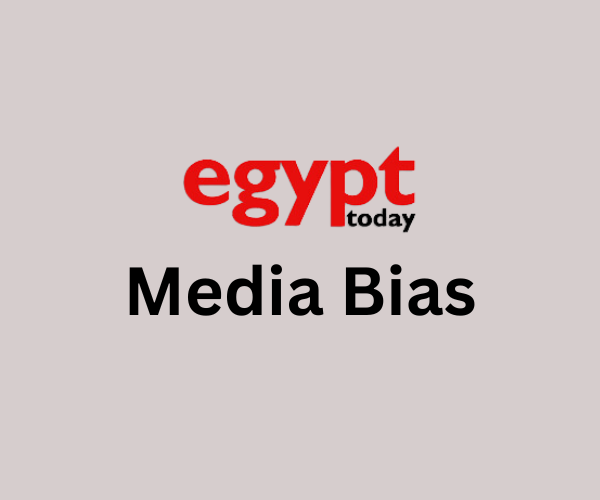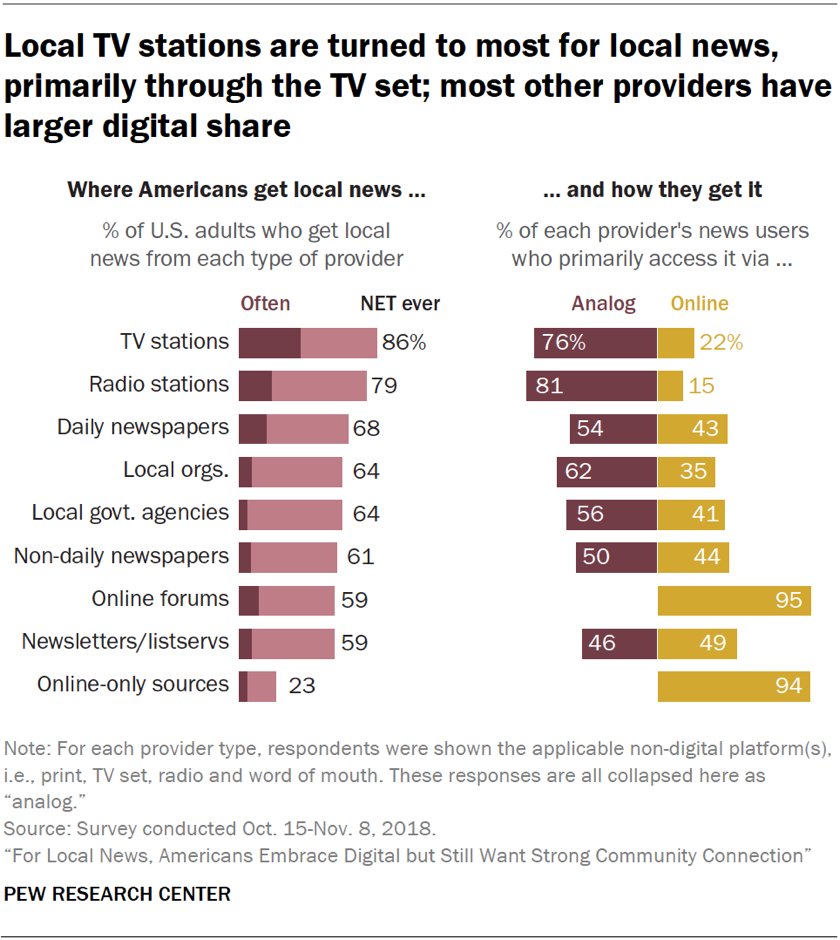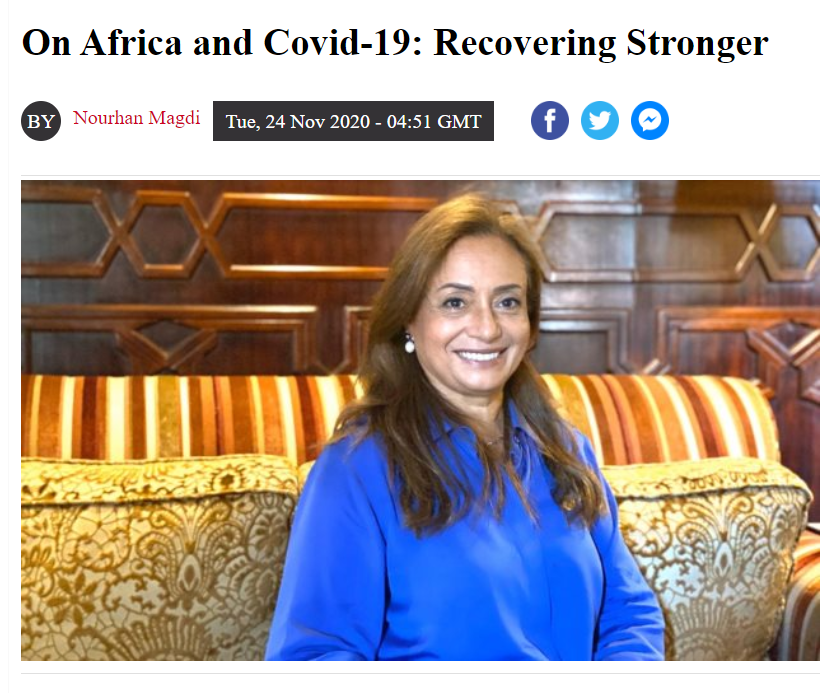
Egypt Today began publishing articles in 1979. Their primary focus is Egyptian news while covering significant international stories. Its history is tied to the political circumstances of Egypt, including the election in 2005 which resulted in its subsequent ban for its reporting. It began publishing online in 2017 once again, expanding its coverage to sports, arts and media, and business in addition to what it previously discussed.
This shift from traditional print to online has proven valuable, as the public has shifted their media consumption with the rise of modern technologies. Pew Research conducted a survey asking where Americans consume their news, finding that online sources are significantly more common than print. While this study applies to local news, it can be used for wider topics. Therefore, Egypt Today has a wider audience because of its extension to online spheres.

Although international, it is not free of political biases. This article analyzes the inherent bias of Egypt Today’s publishing and editing habits. We do so by analyzing the various factors that contribute to not only the bias of Egypt Today but all news sources. Understanding these factors leads to greater media literacy and helps answer the question of whether Egypt Today is a biased source.
How Does Biasly Rate News Sources?
Biasly’s algorithms produce bias ratings to help provide multiple perspectives on given articles. Biasly has analyzed 200,000+ news articles from more than 3,200 news sources through our A.I. technology and team of political analysts to find the most factual, unbiased news stories.
Biasly determines the degree of political bias in news sources by using Biasly’s Bias Meter Rating, in which Biasly’s team analyzes media sources’ reliability and bias and produces three scores, a Reliability Score that measures the accuracy of media sources; an A.I. Bias Score, evaluated by A.I.; and an Analyst Bias Score evaluated by political analysts. These scores are rated based on seven rating metrics including Tone, Tendency, Diction, Author Check, Selection/Omission, Expediency Bias, and Accuracy. These metrics help our analysts to determine the political attitude of the article.
Our A.I. machine-learning system employs natural language processing and entity-specific sentiment analysis to examine individual articles and determine their bias levels. By analyzing the key terms in an article such as policies, bias phrases, political terminologies, politicians, and their nicknames, the algorithms can rate the attitude of the text. Bias scores range from -100% and 100%, with higher negative scores being more liberal and higher positive scores being more conservative, and 0% being neutral.
Is the Egypt Today Politically Biased?
Egypt Today’s Biasly rating is based on two scores, one done by our analysts and another done by AI. Both our Computer Bias Score and Analyst Bias Scores are Center for Egypt Today. This means that they typically avoid either right or left-leaning bias, but it does not mean that all of their articles are politically neutral. Instead, it is an overall review of the political leanings of the source based on reviews done for 15 or more articles by analysts with a left-leaning, right-leaning, and center bias. Our score becomes more accurate as we review more articles, however, their general political neutrality contributes to their Center score. This score is similar to other third-party sources that study media bias.
Audiences of Egypt Today may be lulled into casual readings of their articles without consideration for bias. It is, after all, a typically “Neutral” source external to American politics. However, regardless of any source’s history of neutral reporting, bias is an inherent reporting feature. For new and old readers of Egypt Today alike learning to understand and recognize their own political biases is essential to become more informed media consumers.
Before we begin, we need to discuss bias. Bias is a natural function of humans, and we can express it both consciously and unconsciously. Bias is one of the most fundamental forms of pattern recognition in humans. This isn’t to lower the bar and say that “all things are biased,” but to explain the process in which we may come to trust certain news organizations that display patterns of coverage.
On the media’s part, there is an incentive to retain audiences, encourage them to purchase subscriptions, and rate products positively. Bias is a two-way street, people want to see news stories about things they care about, and the media needs viewers to continue their operations. This creates a positive feedback loop that influences what stories are covered and from what perspective. This also explains the actions of more liberal news organizations.
Analysis of Bias in Egypt Today Articles
When determining any source’s bias, the reader should focus on five metrics: Tone, Tendency, Author, Diction, and Expediency bias. While each of these metrics may be correlated, each demonstrates a unique element that may alter the inherent bias of an article.
- Tone: The author’s general depiction of the topic, which is unique, but may be evidenced by the author’s diction and vocabulary
- Tendency: A measurement of the frequency and consistency of the author’s personal biases in the article.
- Author: The influence of the political and ideological history of the author through previous articles and current views available to the public through social media platforms.
- Diction: The language choices of the author.
- Expediency: The immediate framework the author provides for thinking about the topic, typically the headline, photos, and summaries demonstrating the author’s perspectives.
As an example of these elements, the typical Egypt Today article, “On Africa and Covid-19: Recovering Stronger,” rated as Biasly as “Center,” sets good precedence. First, consider its expediency. When first opening the article, this is what the reader sees:

Both the photo and the photo simply preview what the article intends to discuss, the economic and social recovery in Africa. It wasn’t something that was widely discussed at the time, reporting on Africa’s progress following the initial events of the pandemic. There is nothing inherently biased about the first impressions. It does not try to frame the issue in either a liberal or conservative perspective but rather shows readers what to expect during their read.
The initial tone maintains a “Center” perspective. For example, the introductory paragraph reads:
“As the whole world is still grappling with the pandemic, the Coronavirus crisis has hit Africa quite hard, with the economic damage and health costs leaving the continent in need of an estimated $1.2 trillion over the next three years, the International Monetary Fund (IMF) projects.
Accordingly, an urgent and comprehensive strategy has become a necessity to not only mitigate and contain the crisis, but also for Africa to recover better and stronger.”
The overall tone of this passage does not establish a biased worldview but rather emphasizes a factual description of the impact of COVID-19 on Africa. As an introductory paragraph, the reader can now expect the solutions and strategies employed to help Africa overcome the effects of the pandemic. It is purposefully written to pose the pandemic as a factual human problem, not a political issue to pose with.
The author remains objective when discussing the solutions to various economic and societal issues. For example, in connection to technology, she writes:
“‘The opportunity is the other face for a crisis,’ Abou-Zeid says, adding that the pandemic has forced many countries and even companies to adopt new business models and to expedite digital transformation.
African countries that started earlier to incorporate technology into sectors, like Egypt, have higher economic resilience, she says, adding that ‘it enabled Egypt to manage the crisis very professionally despite the huge economic pressures it encountered.’”
The tone remains politically neutral in discussion with the practical solutions and opportunities. No particular phrases or ideas used are representative of one political party or another but rather focus on the factual interpretation of current circumstances and their resulting consequences. Further discussion regarding other effects of the coronavirus maintains a similar tone.
Diction and Tendency, in consequence, maintain a similar sense of neutrality. In terms of diction, both verbiage and adjectives are used for objective description alone. Consider the two passages above. The most emotional language used is seen in the introductory paragraph, “urgent,” “recover,” and “mitigate.” These words are arguably unemotional, rather logical vocabulary used to accurately describe the needed action to take against the impact of COVID-19. More emotional and descriptive language is found solely in her citations, which include “huge.” In other words, even the citations are toned down to match the political neutrality of the author’s diction. Tendency is simple. As seen from both passages, her range of bias is maintained within the realm of political neutrality from beginning to end.
The author is Nourhan Magdi who, based on her X account, is consistent in her avoidance of overtly politicized messaging. While much of her recent activity has been dedicated to her developing career as a voice actress, posts in the same year as the publication of the article are consistent with her style as an author. For example, a political post in 2020 she wrote reads:
“Libyan parliament voted Saturday to refer all signatories of MoUs signed by Turkish President #Erdogan and #Sarraj on security as well as maritime jurisdictions, to Libya’s top prosecutor on charges of high treason.”
Libyan parliament voted Saturday to refer all signatories of MoUs signed by Turkish President #Erdogan and #Sarraj on security as well as maritime jurisdictions, to Libya’s top prosecutor on charges of high treason. #Libya #Turkey #البرلمان_الليبي https://t.co/0Hv0CSNjk7
— Nourhan Magdi (@NourhanMagdi) January 4, 2020
While each author certainly has their political preferences and ideologies, Magdi refrains from publicly stating her private thoughts online, at least on her X profile. Much of her content, instead seems to be focused on her personal career development and goals. In short, her public media presence reflects the center perspective of her articles, not whatever her private political leanings may be.
The article reflects a “Center” take on a politically divisive issue. This is accomplished through the author’s apparent dedication to neutral reporting on the factual impacts of COVID-19, which is demonstrated through the tone, diction, and other authorial decisions to avoid showing favor toward any particular perspective. In today’s media landscape, articles such as this are difficult to find, even among those written by Egypt Today. As we consume media it is important to remember that each article, each author, and each publisher will have their unique voice and bias. For example, while Egypt Today may tend to avoid political bias, not all of its articles accomplish such neutrality.
Analysis of Egypt Today Opinion Articles
First, it is important to understand the difference between opinion pieces and editorial publications. Editorials focus on objective reporting of the facts, while opinion pieces allow the author to articulate their personal thoughts and biases regarding a particular issue. The key difference is they are openly biased when labeled as an opinion piece, both the author and reader should recognize that the views expressed are the personal thoughts and interpretations of its creator. While Egypt Today focuses on its editorials, it certainly has pieces that are open to both bias and individual interpretation.
Consider the article “I am [not a sexual object, not a commodity, not a burden] a Girl” written by Yasmine Hassan. While it uses language that is fairly objective, it promotes feminist ideas within Egyptian culture. It does not attempt to hide its promotion of left ideas, but rather uses fairly reliable statistics and data to promote women’s rights in Egypt. For example, she writes:
“Seeking to take real and genuine steps toward empowering girls around the world, the annual celebration is not limited to speeches and summits. In 2017, the #GirlsTakeover initiative was launched as a global campaign with the core idea of providing a chance for girls across the world to assume leading roles in technology, politics, business and the media, tearing down the barriers of discrimination.”
While accurately citing the “GirlsTakeover” event, it uses language that promotes the event. Hassan clearly wants readers to walk away with a favorable view toward the promotion of feminist ideals.
Compare this to the article, “Egypt extends condolences over Haitian president’s assassination, calls for restraint”. It is much briefer than the commentary of the previous article, simply stating the position of the Egyptian government on the assassination as well as their recommendations. It refrains from expressing political bias even during a time of immense international turmoil. However, because of the brevity, audiences may be left with a desire to know more about what happened.
While only a portion of the content is available on Egypt Today, it provides a good representation of what readers can expect. Generally promoting a “Center” perspective, their audience should remember that at times Egypt Today may promote political agendas. Remembering to apply the key principles of identifying bias is key in each article independent of both the author and publisher.
Who Owns Egypt Today?
Egypt Today is a subsidiary of Egyptian Media Group, however, Egypt Today does have an Editor-in-chief, Mohamed Abdelbaky. He has been in the position since its republication in 2017. The majority of his X profile promotes Egypt Today’s articles, however, many of his tweets from 2019 are promoting feminist ideals. It appears that his political views generally align with the visible political alignment of Egypt Today, not indicating anything particularly unique. His views, like Egypt Today, appear to be “Center.”
How to Evaluate and Uncover Bias
It can often be difficult to tell if the news you watch is biased. If you have settled on a news channel, it’s usually because you trust the information you are gaining. Unfortunately, many trust the information they are hearing because it confirms what they already believe. This is referred to as “confirmation bias.” It is important to challenge your beliefs and get third-party verification that what you are hearing is the full story. This is why we recommend using Biasly to compare different news stories side-by-side using our bias ratings to figure out what both sides think of a political issue.
Regardless of the “Center” score for Egypt Today, it is important to remember that at times they too can show bias on particular issues. Some articles may lean either to the left or right, it just depends on the author and topic. When considering if the article you are reading is biased, keep in mind, the 5 identifying principles of identifying bias and the type of publication you are reading. In order to help audiences find the bias in their everyday media consumption, Biasly has developed a News Bias & Reliability Checker to help.























